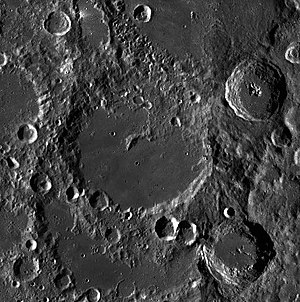From Kármán (moon crater)
| From Kármán | ||
|---|---|---|

|
||
| Image of the Lunar Reconnaissance Orbiter | ||
|
|
||
| position | 44.81 ° S , 176.28 ° O | |
| diameter | 187 km | |
| Card sheet | 119 (PDF) | |
| Named after | Theodore von Kármán (1881–1963) | |
| Named since | 1970 | |
| Unless otherwise stated, the information comes from the entry in the IAU / USGS database | ||
Von Kármán is a lunar crater on the back of the moon in the southern hemisphere, named in honor of the Hungarian physicist and aeronautical engineer Theodore von Kármán . On January 3, 2019, 3:26 a.m. CET , the Chinese Chang'e-4 space probe landed a man-made object softly on the back of the moon for the first time .
The north-eastern third of the Von Kármán crater is covered by the crater rim of the Leibnitz crater ; the rest of the structure is still well preserved. Approximately in the middle of the crater, around 46 km northwest of the landing site of Chang'e-4, is the central mountain of the crater with a diameter of 24 km and a height of 1565 m above the crater floor. On February 4, 2019, the mountain was named "Mons Tai" or 泰山 (Pinyin Tài Shān ) by the International Astronomical Union , after the holy mountain Tai Shan in the east Chinese province of Shandong . The landing site itself was named "Basis Milchstraße" or 天河 基地 (Pinyin Tiānhé Jīdì ), a reference to the legend of the cowherd and the weaver , where the Milky Way separates the two lovers and only once a year from a flock of magpies that form a bridge (today's relay satellite Elsternbrücke ) is bridged. The Latin name of the landing site is "Statio Tianhe".
A small crater 3.8 km in diameter west of the landing site was called "Zhinyu", a somewhat idiosyncratic transcription of von (Pinyin Zhīnǚ ), the weaver from the legend, requested by the Chinese side . A small crater 2.2 km in diameter south of the landing site was given the name "Hegu" or 河鼓 (Pinyin Hégŭ , about 'The Drum on the Yellow River '), like Zhinyu a constellation in the so-called " Residence Ox " (牛 宿) from traditional Chinese astronomy. The star Hegu 2, known to Western astronomers as Altair , is the legendary cowherd. A small crater 3.9 km in diameter northeast of the landing site was named "Tianjin" or 天津 (Pinyin Tiānjīn ), not after the city of the same name on the east coast of China, but after the constellation "Heavenly Ford" in the "girl's residence" corresponding to the western constellation Swan . Tianjin is the name of a fairy who, in the legend, escorts the cowherd and the weaver.

| Letter | position | diameter | link |
|---|---|---|---|
| L. | 47.67 ° S , 177.89 ° O | 27 km | [1] |
| M. | 49.03 ° S , 174.16 ° O | 217 km | [2] |
| R. | 46.03 ° S , 170.7 ° O | 26 km | [3] |
Others
Theodore von Kármán was the doctoral supervisor of Qian Xuesen , the father of Chinese space travel.
Individual evidence
- ↑ China successfully lands Chang'e-4 on far side of Moon on planetary.org , January 3, 2019; accessed on January 3, 2019
- ↑ Planetary Names: Mons, montes: Mons Tai on Moon. In: planetarynames.wr.usgs.gov. February 4, 2019, accessed April 25, 2020 .
- ↑ Planetary Names: Landing site name: Statio Tianhe on Moon. In: planetarynames.wr.usgs.gov. February 18, 2019, accessed April 25, 2020 .
- ↑ Planetary Names: Crater, craters: Zhinyu on Moon. In: planetarynames.wr.usgs.gov. February 4, 2019, accessed April 25, 2020 .
- ↑ Planetary Names: Crater, craters: Hegu on Moon. In: planetarynames.wr.usgs.gov. February 4, 2019, accessed April 25, 2020 .
- ↑ Planetary Names: Crater, craters: Tianjin on Moon. In: planetarynames.wr.usgs.gov. February 4, 2019, accessed April 25, 2020 .
- ↑ 陈海波: 月球 上 多 了 5 个 中国 名字. In: xinhuanet.com. February 16, 2019, accessed April 25, 2020 (Chinese).
- ↑ Li Chunlai , Su Yan et al .: The Moon's farside shallow subsurface structure unveiled by Chang'E-4 Lunar Penetrating Radar. In: advances.sciencemag.org. February 26, 2020, accessed April 25, 2020 .
- ↑ 钱学森 导师 冯 卡门 的 3 大 中国 弟子 , 个 个人 中 龙凤. In: shkp.org.cn. December 22, 2019, accessed April 2, 2020 (Chinese).
Web links
- By Kármán in the Gazetteer of Planetary Nomenclature of the IAU (WGPSN) / USGS
- From Kármán Digital Lunar Orbiter Photographic Atlas of the Moon
